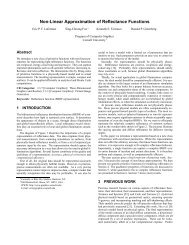pigmented colorants: dependence on media and time - Cornell ...
pigmented colorants: dependence on media and time - Cornell ...
pigmented colorants: dependence on media and time - Cornell ...
You also want an ePaper? Increase the reach of your titles
YUMPU automatically turns print PDFs into web optimized ePapers that Google loves.
over white grounds) suffer the greatest rate of color change. Finally, the fading<br />
will appear to slow, but <strong>on</strong>ly after most of the glaze has been lost (absorbing very<br />
little light). Note that the first two stages of fading are easily recognized from the<br />
Munsell plots of the alizarin crims<strong>on</strong> glazes in Figure 4.17.<br />
The model predicts that <strong>on</strong>ly absorpti<strong>on</strong> determines the fading rate. The fact<br />
that the colorant c<strong>on</strong>centrati<strong>on</strong> does not affect the colorant loss rate (pale tints<br />
do not lose their colorant faster than that of darker colors) has been previously<br />
observed [GED64, JFFBC84]. However, while prior fading should not affect the<br />
loss rate, this was not the case experimentally. Whitmore <strong>and</strong> Bailie noted that<br />
older <str<strong>on</strong>g>colorants</str<strong>on</strong>g> seem more resistant than fresh <strong>on</strong>es to further fading (given the<br />
same c<strong>on</strong>centrati<strong>on</strong>s). The authors list possible discrepancies: the pigment may<br />
either react to form products that influence further fading, or originally have been<br />
a mixture of comp<strong>on</strong>ents with different individual fading rates (different particle<br />
sizes, previous fading of <strong>on</strong>e of the c<strong>on</strong>stituents, etc).<br />
Pigments scatter incident light, which in turn, increases the depth of which<br />
photochemical processes occur. Johnst<strong>on</strong>-Feller showed that the depth of fading<br />
in paints from accelerated aging is decreased as the c<strong>on</strong>centrati<strong>on</strong> of white pigment<br />
decreases in a tint. (Figure 4.19). White pigments scatter light deeper into the<br />
paint, <strong>and</strong> hence fading occurs deeper within the paint if there is more white<br />
present.<br />
Yet, the behavior of fading taking place <strong>on</strong>ly in the upper porti<strong>on</strong> of the paint<br />
sample is important for analysts attempting to classify materials in a work. If the<br />
surface has faded substantially, it is possible to view relatively unfaded material<br />
underneath via cross-secti<strong>on</strong>s, revealing many of the original <str<strong>on</strong>g>colorants</str<strong>on</strong>g> [Fel94].<br />
128



